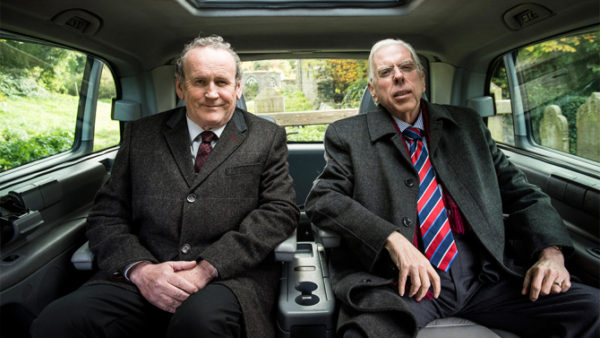The “troubles” in Northern Ireland, which for decades violently pitted Protestants against Catholics, were finally resolved when their respective leaders, Ian Paisley and Martin McGuinness, agreed to form a national coalition government. The manner in which these hardened politicians created the conditions for this historic rapprochement unfolds in Nick Hamm’s absorbing film, The Journey, which opens in Canada on July 7.
Paisley, the leader of the Democratic Unionist Party, and McGuinness, the head of the Irish Republican Army, were bitter enemies when British Prime Minister Tony Blair invited them to Scotland in 2006 for peace talks. Previous attempts at reconciliation had failed, but Blair’s advisor thought this initiative had a chance of succeeding, calculating that their common interests would override their well-known differences.
Thanks to clever maneuvering by the British, the feuding pair were seated next to each other in a van heading to Glasgow airport, where a private plane would fly them back to Belfast. Paisley (Timothy Spall) was going home to celebrate his 50th wedding anniversary, while McGuinness (Colm Meaney) was returning to confer with colleagues. It was Blair’s hope that their close proximity to each other would melt barriers and lead to successful peace negotiations in Scotland.
Hamm uses these actual events to concoct an imagined version of their conversations en route to the airport.

At first, Paisley and McGuinness do not exchange a word and barely glance at each other. McGuinness breaks the ice by engaging in small talk. Paisley, a scowl on his face, remains in a combative frame of mind and resolutely refuses to lend McGuinness his cell phone.
As the mood slowly improves, Paisley makes a reference to his beloved wife. But in a sharp critique of his methods, McGuinness claims that Paisley has damaged his cause.
Unbeknownst to them, their exchanges are being taped and streamed back live to Scotland. The driver of the van, an amiable young man working for the British intelligence service, deliberately crashes the vehicle. The “accident” enables Paisley and McGuinness to continue talking.
With their mutual hostility diminishing, McGuinness acknowledges that the bloodshed has to stop. Paisley admits that his bark is worse than his bite. “Maybe we have to learn to build things differently,” Paisley says. “What are you saying?” McGuinness asks.
By now, it seems clear that both men are looking for a way out of the violence that has convulsed Northern Ireland for so long.
An act of kindness by McGuinness convinces Paisley that peace may be possible. They clash again before realizing that the status quo is unsustainable.
Although the dialogue is a figment of Hamm’s fertile imagination, it’s plausible. Top-notch performances by Spall and Meaney add to the movie’s credibility.
The Journey, brimming with cautious optimism about the ability of enemies to set aside their hostility for the sake of coexistence, tempts a viewer to think that bitter conflicts can be resolved if both sides act in the interests of their respective constituencies.